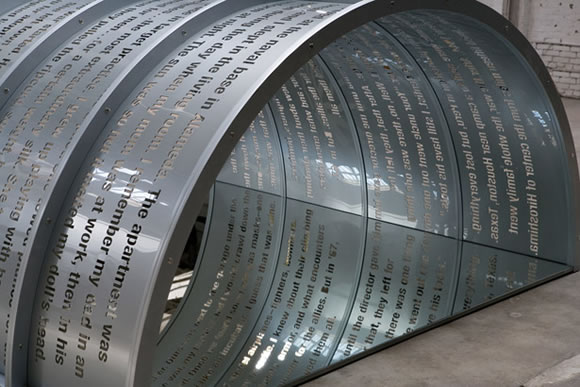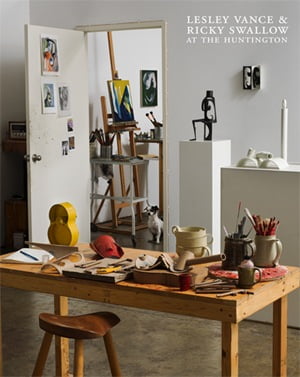NEW CANAAN, Conn. – The Glass House is pleased to present Personal Effect: Works from the Collections of Philip Johnson and David Whitney this spring in our Painting Gallery, the structure designed and built by Philip Johnson in 1965 to house the personal collection so carefully acquired by both men.
The array of work gives a sense of the collecting habits of the couple, together since 1960 and only separated by their deaths in 2005, who formed close bonds with many of the seminal figures of 20th-century art. The smaller works, presented in the entrance foyer of the gallery, in some cases have dimensions less than a standard piece of paper and thus have a precious and intimate quality. These relate to Johnson and Whitney’s life in art and their kinship with the artists who created these works.
These smaller works in the Painting Gallery’s foyer are among those from the holdings at the Glass House that have never been on view to the public. These include a selection of the most personal pieces from the collections of Johnson and Whitney – in many cases, gifts from the artists themselves, from the untitled oil on canvas of 1971 by Jasper Johns for David Whitney to literal birthday wishes to Philip Johnson from Frank Stella and Michael Graves. A portrait by Warhol – a work of pencil on paper executed in 1977 – was a gift to Philip Johnson that same year. (Note, it was Whitney who introduced Johnson to Warhol in the early 1960s.) A work of ink on paper, Untitled, 1990, by Rauschenberg is inscribed to Johnson.
A delicate linocut by Vija Celmins, Comet, 1992, is the initial work to be seen by visitors upon entering the exhibition. Al Taylor’s, Untitled (Study for Distill), 1988, a gift of the artist the same year that the work Distill itself was acquired by Johnson and Whitney, is installed just across the room.
Beside these personal pieces of the 1970s, 1980s and 1990s are two untitled works in pencil on paper of 1916 by Kazimir Malevich – part of David Whitney’s personal collection and an obvious link to both men’s appreciation of the earliest stages of Modern art in the 20th Century.
On display will also be major works from the permanent collection, some of which have not been formally exhibited at the Glass House in years, including the 1972 nine-image portrait of Philip Johnson by Andy Warhol. This portrait is of a softer palette than typically associated with Warhol, which is especially sympathetic to the colors present at the Glass House site itself. This piece is accompanied by Michael Heizer’s, Dragged Mass (Iso/Planar/Section), 1983, a colorful work that for years graced Philip Johnson’s offices in New York. Heizer is an artist who Whitney especially championed.
Robert Rauschenberg’s Recital (Spread), 1980 is a sizable mixed-media work that comprises a working fan. Several works by the artist remain in the Glass House’s collection including Empire II, 1961, now shown in the Sculpture Gallery. Adjacent to Recital (Spread) is David Salle’s Miner, 1985, the largest piece in the show at a width of 162 ¼”. Both works were purchased the year they were produced. Salle’s untitled watercolor of 1986 is in the foyer — a gift to David Whitney in 1987.
Two early works by Frank Stella, Tetuan II, 1964 and Averroes, 1960 are placed at the center of the Painting Gallery. Stella has an essential place in the Glass House’s collection overall, with additional works currently stored, but not currently on view, in the Painting Gallery and several pieces on display in the adjacent Sculpture Gallery, all of which range from the 1960s to the 1990s.
Stella also exerted a special influence on Johnson’s last architectural design on site, Da Monsta of 1995. Note Stella’s Shards I (model), 1981-1982 was originally installed within Da Monsta; this model is now on display in the gallery’s foyer.
Clearly, only a sampling of the extraordinary eye for art both men possessed.
About the Glass House: The Glass House, built between 1949 and 1995 by architect Philip Johnson, is a site of the National Trust for Historic Preservation located in New Canaan, CT. The pastoral 49-acre landscape comprises fourteen structures, including the Glass House (1949), and features a permanent collection of 20th-century painting and sculpture, along with temporary exhibitions.The campus serves as a catalyst for the preservation and interpretation of modern architecture, landscape, and art; and a canvas for inspiration
and experimentation, honoring the legacy of Philip Johnson (1906 -2005) and his partner, David Whitney (1939 -2005). The tour season runs from May through November and advance reservations are required.
The National Trust for Historic Preservation is a privately funded nonprofit organization that works to save America’s historic places to enrich our future, reimagining historic sites for the 21st century. The guiding principle of this initiative is that historic sites must be dynamic, relevant, and evolving in order to foster an understanding of history and culture that is critical, sensory, and layered.
Exhibition curated by Hilary Lewis, Chief Curator & Creative Director
The Glass House Visitor Center and Design Store
199 Elm Street, New Canaan, CT 06840
203.594.9884
Open Thursday – Monday, May 1 – November 30, 9:30 am – 5:30 pm
Tickets start at $25, including a tour of the site.
www.theglasshouse.org



